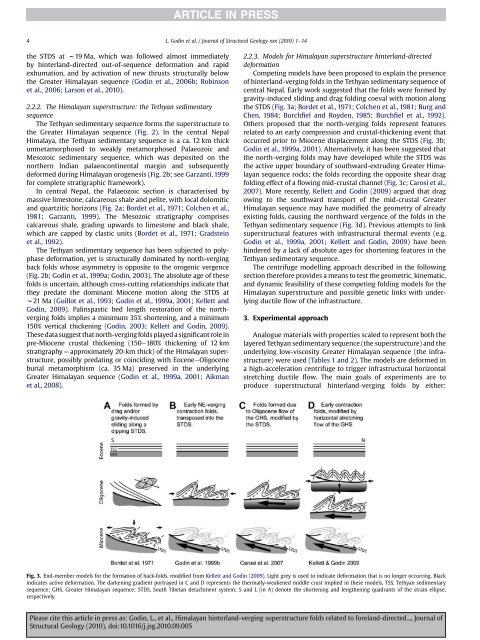Himalayan hinterland-verging superstructure folds related to ...
Himalayan hinterland-verging superstructure folds related to ...
Himalayan hinterland-verging superstructure folds related to ...
Create successful ePaper yourself
Turn your PDF publications into a flip-book with our unique Google optimized e-Paper software.
4L. Godin et al. / Journal of Structural Geology xxx (2010) 1e14the STDS at w19 Ma, which was followed almost immediatelyby <strong>hinterland</strong>-directed out-of-sequence deformation and rapidexhumation, and by activation of new thrusts structurally belowthe Greater <strong>Himalayan</strong> sequence (Godin et al., 2006b; Robinsonet al., 2006; Larson et al., 2010).2.2.2. The <strong>Himalayan</strong> <strong>superstructure</strong>: the Tethyan sedimentarysequenceThe Tethyan sedimentary sequence forms the <strong>superstructure</strong> <strong>to</strong>the Greater <strong>Himalayan</strong> sequence (Fig. 2). In the central NepalHimalaya, the Tethyan sedimentary sequence is a ca. 12 km thickunmetamorphosed <strong>to</strong> weakly metamorphosed Palaeozoic andMesozoic sedimentary sequence, which was deposited on thenorthern Indian palaeocontinental margin and subsequentlydeformed during <strong>Himalayan</strong> orogenesis (Fig. 2b; see Garzanti, 1999for complete stratigraphic framework).In central Nepal, the Palaeozoic section is characterised bymassive limes<strong>to</strong>ne, calcareous shale and pelite, with local dolomiticand quartzitic horizons (Fig. 2a; Bordet et al., 1971; Colchen et al.,1981; Garzanti, 1999). The Mesozoic stratigraphy comprisescalcareous shale, grading upwards <strong>to</strong> limes<strong>to</strong>ne and black shale,which are capped by clastic units (Bordet et al., 1971; Gradsteinet al., 1992).The Tethyan sedimentary sequence has been subjected <strong>to</strong> polyphasedeformation, yet is structurally dominated by north-<strong>verging</strong>back <strong>folds</strong> whose asymmetry is opposite <strong>to</strong> the orogenic vergence(Fig. 2b; Godin et al., 1999a; Godin, 2003). The absolute age of these<strong>folds</strong> is uncertain, although cross-cutting relationships indicate thatthey predate the dominant Miocene motion along the STDS atw21 Ma (Guillot et al., 1993; Godin et al., 1999a, 2001; Kellett andGodin, 2009). Palinspastic bed length res<strong>to</strong>ration of the north<strong>verging</strong><strong>folds</strong> implies a minimum 35% shortening, and a minimum150% vertical thickening (Godin, 2003; Kellett and Godin, 2009).These data suggest that north-<strong>verging</strong> <strong>folds</strong> played a significant role inpre-Miocene crustal thickening (150e180% thickening of 12 kmstratigraphy ¼ approximately 20-km thick) of the <strong>Himalayan</strong> <strong>superstructure</strong>,possibly predating or coinciding with EoceneeOligoceneburial metamorphism (ca. 35 Ma) preserved in the underlyingGreater <strong>Himalayan</strong> sequence (Godin et al., 1999a, 2001; Aikmanet al., 2008).2.2.3. Models for <strong>Himalayan</strong> <strong>superstructure</strong> <strong>hinterland</strong>-directeddeformationCompeting models have been proposed <strong>to</strong> explain the presenceof <strong>hinterland</strong>-<strong>verging</strong> <strong>folds</strong> in the Tethyan sedimentary sequence ofcentral Nepal. Early work suggested that the <strong>folds</strong> were formed bygravity-induced sliding and drag folding coeval with motion alongthe STDS (Fig. 3a; Bordet et al., 1971; Colchen et al., 1981; Burg andChen, 1984; Burchfiel and Royden, 1985; Burchfiel et al., 1992).Others proposed that the north-<strong>verging</strong> <strong>folds</strong> represent features<strong>related</strong> <strong>to</strong> an early compression and crustal-thickening event tha<strong>to</strong>ccurred prior <strong>to</strong> Miocene displacement along the STDS (Fig. 3b;Godin et al., 1999a, 2001). Alternatively, it has been suggested thatthe north-<strong>verging</strong> <strong>folds</strong> may have developed while the STDS wasthe active upper boundary of southward-extruding Greater <strong>Himalayan</strong>sequence rocks; the <strong>folds</strong> recording the opposite shear dragfolding effect of a flowing mid-crustal channel (Fig. 3c; Carosi et al.,2007). More recently, Kellett and Godin (2009) argued that dragowing <strong>to</strong> the southward transport of the mid-crustal Greater<strong>Himalayan</strong> sequence may have modified the geometry of alreadyexisting <strong>folds</strong>, causing the northward vergence of the <strong>folds</strong> in theTethyan sedimentary sequence (Fig. 3d). Previous attempts <strong>to</strong> linksuperstructural features with infrastructural thermal events (e.g.Godin et al., 1999a, 2001; Kellett and Godin, 2009) have beenhindered by a lack of absolute ages for shortening features in theTethyan sedimentary sequence.The centrifuge modelling approach described in the followingsection therefore provides a means <strong>to</strong> test the geometric, kinematic,and dynamic feasibility of these competing folding models for the<strong>Himalayan</strong> <strong>superstructure</strong> and possible genetic links with underlyingductile flow of the infrastructure.3. Experimental approachAnalogue materials with properties scaled <strong>to</strong> represent both thelayered Tethyan sedimentary sequence (the <strong>superstructure</strong>) and theunderlying low-viscosity Greater <strong>Himalayan</strong> sequence (the infrastructure)were used (Tables 1 and 2). The models are deformed ina high-acceleration centrifuge <strong>to</strong> trigger infrastructural horizontalstretching ductile flow. The main goals of experiments are <strong>to</strong>produce superstructural <strong>hinterland</strong>-<strong>verging</strong> <strong>folds</strong> by either:Fig. 3. End-member models for the formation of back-<strong>folds</strong>, modified from Kellett and Godin (2009). Light grey is used <strong>to</strong> indicate deformation that is no longer occurring. Blackindicates active deformation. The darkening gradient portrayed in C and D represents the thermally-weakened middle crust implied in these models. TSS, Tethyan sedimentarysequence; GHS, Greater <strong>Himalayan</strong> sequence; STDS, South Tibetan detachment system; S and L (in A) denote the shortening and lengthening quadrants of the strain ellipse,respectively.Please cite this article in press as: Godin, L., et al., <strong>Himalayan</strong> <strong>hinterland</strong>-<strong>verging</strong> <strong>superstructure</strong> <strong>folds</strong> <strong>related</strong> <strong>to</strong> foreland-directed..., Journal ofStructural Geology (2010), doi:10.1016/j.jsg.2010.09.005
















